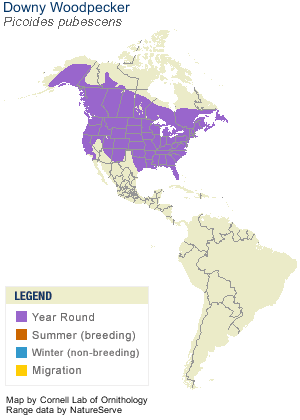
Downy Woodpecker
The active little Downy Woodpecker is a familiar sight at backyard feeders and in parks and woodlots, where it joins flocks of chickadees and nuthatches, barely outsizing them. An often acrobatic forager, this black-and-white woodpecker is at home on tiny branches or balancing on slender plant galls, sycamore seed balls, and suet feeders. Downies and their larger lookalike, the Hairy Woodpecker, are one of the first identification challenges that beginning bird watchers master.
Keys to identification
Typical Voice
[audio:http://backyardnaturalist.ca/wp-content/uploads/2011/05/downy.mp3|titles=downy]-
Size & Shape
Downy Woodpeckers are small versions of the classic woodpecker body plan. They have a straight, chisel-like bill, blocky head, wide shoulders, and straight-backed posture as they lean away from tree limbs and onto their tail feathers. The bill tends to look smaller for the bird’s size than in other woodpeckers.
-
Color Pattern
Downy Woodpeckers give a checkered black-and-white impression. The black upperparts are checked with white on the wings, the head is boldly striped, and the back has a broad white stripe down the center. Males have a small red patch on the back of the head. The outer tail feathers are typically white with a few black spots.
-
Behavior
Downy Woodpeckers hitch around tree limbs and trunks or drop into tall weeds to feed on galls, moving more acrobatically than larger woodpeckers. Their rising-and-falling flight style is distinctive of many woodpeckers. In spring and summer, Downy Woodpeckers make lots of noise, both with their shrill whinnying call and by drumming on trees.
-
Habitat
You’ll find Downy Woodpeckers in open woodlands, particularly among deciduous trees, and brushy or weedy edges. They’re also at home in orchards, city parks, backyards and vacant lots.

